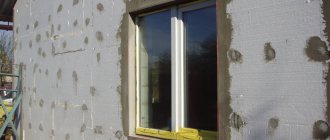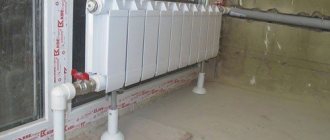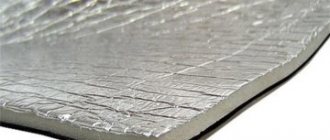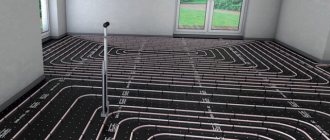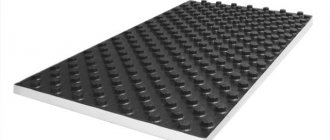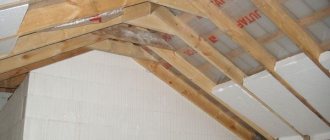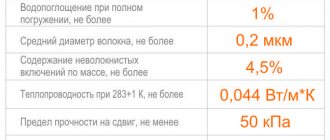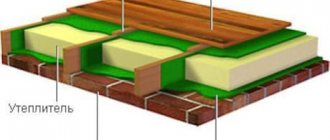Last time we talked about what liquid ceramic thermal insulation is, its characteristics and areas of application. Today we will talk about the already familiar material made of polyethylene foam. We will reveal effective and quick methods for insulating floors with Izolon, as well as walls and ceilings. Let’s say in advance that to obtain a high-quality thermal insulation layer, you need to use thick insulation, from 50 mm or more. Although the thermal conductivity of Izolon is quite low, with such a small thickness, frankly speaking, it is impossible to properly insulate. At the same time, the material has other useful qualities.
Description of material
Isolon thermal insulation consists of artificially foamed polyethylene, which has the form of small cells or pores. Increased thermal insulation characteristics are achieved thanks to the porous structure. Using it, various surfaces and entire structures are insulated and waterproofed. The finished material can be in the form of a sheet, tape, block or roll.
The main scope of application is hydro, sound and thermal insulation. It is also used in household tasks, as it has better characteristics compared to similar products. The special structure makes isolon a durable and wear-resistant material.
It is often used in conjunction with other insulators. For example, if the task is thermal insulation of the surface, it is combined with polystyrene foam or expanded polystyrene. This “pie” allows for high-quality insulation of walls, interfloor ceilings and loggias. It also serves as an insulating coating when screeding floors. It is also used in car production - it insulates bodies and protects metal parts from corrosion.
Composition and technical characteristics
To make isolon, polyethylene is foamed, which explains its structure - air pores closed in the synthetic “body”. Despite its elasticity, the material is quite soft, so it is convenient when working with geometrically complex surfaces. When making isolon, a thin foil layer of aluminum is made, the task of which is to reflect heat back into the room. As a result, it is possible to reduce the thickness of the insulation layer itself (the usual thickness for other products is 50-100 mm). The initial thickness of isolon is 2 mm, but if necessary it is increased to 100 mm. It all depends on the area in which it is used. For example, to insulate a balcony, you will need insulation 20-30 mm thick.
Depending on the production method, there are two types of isolon: NPE and PPE (non-crosslinked polyethylene foam and crosslinked). They will be discussed in more detail below, and the technical characteristics of both options are in the table below.
| Index | PPE | NPE |
| Density | 33 kg/m3 | 24 – 45 kg/m3 |
| Operating temperature range | -60 to +75 degrees | -80 to +80 degrees |
| Thermal conductivity | 66 W/mK | 0.040 W/mK |
| Water absorption | 0,01 | 0,01 |
| Vapor permeability | 0.001 mg/(m*h*Pa) | 0.001 mg/(m*h*Pa) |
| Sound absorption | About 60% at 6000 Hz | from 3 to 13% |
Comparison of properties
To understand the difference between these materials, it is necessary to take a closer look at all their differences.
Properties of foamiran
Since the basis of this material is foamed rubber, as a result of its manufacture it turns out to be very light and flexible. That is, foamiran can not only stretch well, but also take any shape. In addition, it is worth noting that the form that this material takes is immediately preserved. Sheets of foamiran can be cut without much difficulty into the parts necessary for the master. Another very important point is that this material has water-repellent properties. Therefore, the finished product can be washed in case of contamination without worrying about the consequences.
It should also be noted that the material is environmentally friendly.
Since foamiran sheets have a porous structure, they lend themselves perfectly to painting. Most often, oil or acrylic paints are used for painting. In some cases, experienced needlewomen even use cosmetic shadows or crayons for this. To prevent the coating from wearing off in the future, it can be secured on top with varnish: either glossy or matte.
Despite the large number of advantages, there are also some disadvantages of this material. First of all, the price is too high, as well as the susceptibility to deformation. In addition, if the material is not used correctly, it will be easy to tear.
Properties of isolon
To begin with, it is worth considering the positive aspects of this material. First of all, isolon is a fairly dense and durable material, so it will be difficult to tear. You can cut isolon not only with scissors, but also with a cutter. Just like foamiran, isolon is hypoallergenic, lightweight, and melts quickly. This material is not afraid of moisture, is not susceptible to mold and is perfectly fixed.
When making flowers, pastels are most often used for coloring, which gives them a similarity to real flowers. However, painting can be done with acrylic paints and other dyes. Izolon does not emit toxins at all and does not have an unpleasant chemical odor.
However, this material also has some disadvantages, which differ in many ways from foamiran. First of all, it may be damaged during transportation. In addition, isolon quickly becomes covered with dust and can also quickly become electrified. For this reason, it is best to store it in a plastic bag, and finished products should be coated with a solution specially made for this purpose.
Specifics of Izolon
Izolon is produced by foaming polyethylene with small cells and closed pores
Izolon based on fine-cell polyethylene foam has high thermal insulation properties and low weight. Some modifications are made with single- or double-sided lamination with aluminum foil. The thickness of the coating is 14 microns and provides waterproofness as well as reflective properties.
The material also has a reinforced frame in the form of a propylene mesh. The basis of Isolon is self-adhesive or glueless. There are combined varieties with foil and adhesive base on sale. To prevent the sheets from sticking together during transportation, a protective film is applied to the adhesive surface.
Sources of cold
Even if during construction you spared no expense on thermal insulation of the roof and foundation, there are other areas through which heat can escape:
- First of all, these are entrance doors and windows;
- Balcony, if available.
- Walls - in the event that the builders “scraped” and did not treat the work process with due professionalism.
Minimizing heat loss and maintaining comfort in your home directly depends on high-quality insulation. In addition, good thermal insulation will significantly save your money on heating costs, since the current price of energy is quite high.
Foil material is suitable for baths and saunas, retains heat perfectly and maintains the required temperature
How does insulation work?
Heat is transferred through infrared rays, invisible to the human eye, but capable of heating opaque objects. In addition, this radiation can also be reflected from mirror surfaces.
Izolon brand insulation is based on this principle. Being located between two walls, or between the finishing and the outer wall, isolon reflects infrared rays back into the room, radically reducing heat loss, and therefore increasing the efficiency of heating systems and reducing the cost of maintaining the desired temperature in the room.
Kinds
The following types are available:
- uncrosslinked – NPE;
- cross-linked – PPE, which is divided into subtypes: chemically cross-linked PPE NX and physically cross-linked PPE NR.
In terms of its characteristics, isolon NPE is inferior to cross-linked ones.
Izolon PPE is resistant to aggressive influences and has higher heat, sound and moisture insulation values. It is possible to combine different types in one product.
To reduce losses from radiation of heat waves absorbed by the internal surfaces of the room, a fairly simple but very effective method is used - covering the isolon with foil. The role of foil is its ability to reflect infrared rays. This significantly increases the importance of isolon in its fight against heat loss.
Please note: Mineral wool characteristics and properties
Foil-coated isolon comes in the following modifications:
- “A” – one-sided foil coating;
- “B” – coated on both sides at once, which increases resistance to external influences;
- “C” – self-adhesive;
- “ALP” – self-adhesive, with a protective film.
Insulation with foil must be laid in such a way that its metallized layer “looks” into the insulated room
When laying foil-coated isolon with a protective film, it should be carefully removed, freeing the surface with the applied adhesive composition. If a non-self-adhesive option is used, then you should use glue that is suitable for this purpose in terms of its properties.
Some varieties of isolon have a high wettability value, which facilitates the use of glue for their fastening.
Advantages and disadvantages
Do-it-yourself insulation of a bathhouse with isolon: the method of specialists
This material is made on the basis of foamed polyethylene. It has different thickness and appearance of the coating. It also reflects the heat emanating from the walls.
Izolon is resistant to sudden temperature changes. It retains its appearance and properties at temperatures from -85 to +125 C.
the material has a different texture: uniform or cross-linked. Choose any option for insulating the bathhouse.
The advantages of isolon are:
- heat retention up to 90%;
- minimal reduction in steam room area;
- it is possible to independently insulate the walls of the steam room with this material;
- Isolon is resistant to moisture;
- affordable cost of material;
- no corrosion;
- When the material heats up, it does not produce harmful substances.
But this material also has disadvantages:
- sizing of joints is required;
- there is exposure to mechanical damage.
It is best to choose roll insulation for a bathhouse. It is much more convenient to work with him.
Basic properties
Many consumers are wondering what isolon is. If you are also one of them, you should know that the material does not perceive temperature changes and does not change parameters when they fluctuate sharply. The structure is characterized by high noise insulation qualities, while the thickness is relatively small.
Izolon is quite often used by motorists for interior decoration. It is impervious to moisture and is able to protect metal from corrosion. For the hood, you should purchase a foil version that is laid on mastic. In order to avoid installation difficulties, it is better to purchase insulation with an adhesive surface; it can even be laid on a base with complex geometry.
If you are wondering what isolon is, then you should also know that this material is durable and reliable. It does not require additional maintenance during operation, is fireproof, does not support combustion, but evaporates. At the same time, it decomposes into carbon dioxide and water.
The main purpose is repair work inside buildings. When creating self-leveling floors, a thin layer of thermal insulation is laid to prevent the solution from leaking to the lower floors. The layer acts as thermal protection and a water barrier, which is important when renovating multi-story buildings.
Among the main properties, ease of installation should be highlighted. The canvas will need to be laid out and secured. In the case of walls, ventilation must be provided. When insulation is carried out from the inside, in the absence of an air layer, the materials will collapse. This is due to the fact that they are hygroscopic and should be protected from moisture or provided with drying and ventilation.
When answering your question about what isolon is, you should know that it can also be used externally. This is due to the fact that the material is resistant to ultraviolet radiation. Due to the fact that isolon has high sound insulation properties, it can be used as insulation for a balcony; it will not decompose under the influence of ultraviolet radiation and will not attract insects, rodents and birds.
Amateurish technology
The origins of balcony disasters originate in the following statements:
- “for normal high-quality insulation of a loggia, in order for it to be as warm as in an apartment, ordinary insulation with a thickness of 10 millimeters is enough
“; - using expanded polystyrene is “ the height of stupidity and inefficiency
,” since isolon “
has higher thermophysical characteristics
.”
Based on these stupid tips, people are sold a miracle technology for insulating balconies and loggias, which is built according to the following scheme:
The author of the above statements and thermal insulation technology is a person who can speak confidently on camera, but does not understand construction and repairs.
We called his technology
Amateurish
. After all, any competent builder knows that 1 cm of isolon is extremely insufficient for insulating balconies and loggias. Further in the text we will confirm our words.
REMINDER. Expanded polystyrene (foam) or mineral wool are often used for thermal insulation of building structures. Both of these materials retain heat approximately equally, but the main thing is that they are laid in layers not 1 cm thick, but on average 10 cm thick. Perhaps this is because they are really much worse than the super insulation isolon and are not capable of protecting the balcony from frost with the thickness of a finger? But is this really so?
Argument No. 2. Super insulation is a myth
The first indicator of thermal efficiency - the ability of a material to retain heat - is the thermal conductivity coefficient, which is denoted by the letter "?" – lambda.
? (W/m°C) is the amount of heat in watts (W) passing through a layer of material 1 m (meter) thick if the temperature difference between its opposing surfaces is 1 °C (degree Celsius).
- How ? The smaller the better the insulator.
- ? depends on the nature of the material and does not depend on its thickness. Coefficient of thermal conductivity ? is a laboratory value that is measured on samples of the same size.
Place two frying pans on the fire - one with cast iron and one with plastic handles. Soon the handle of the first frying pan will become scalding hot, and the handle of the second will remain cold. This is a result of the fact that metal has a much higher thermal conductivity coefficient than plastic.
Let's compare the lambdas of several popular insulation materials. Data about them can be found on the websites of thermal insulation manufacturers, as well as in regulatory documents (we took higher values from SP 50.13330.2012):
- Izolon (foamed polyethylene) – 0.036-0.05;
- EPPS – extruded polystyrene foam (TechnoNIKOL) – 0.030-0.034;
- EPS – expanded polystyrene, polystyrene foam (GOST 15588.2014) – 0.035-0.059;
- Stone wool (Rockwool) – 0.035-0.048.
CONCLUSION: Coefficients? all materials are from approximately the same range. Statement that isolon “ has higher thermophysical characteristics
” – illiterate.
Methods for laying isolon
When insulating the walls of a house from the inside with the help of such a reflective heat-insulating material, it can be laid both between two walls and between the outer wall and the internal finishing surface.
In both cases, there will be a reflection of not only the heat coming from inside the room, but also the cold coming from outside. This is achieved by foiling the insulation, which can be one-sided or two-sided.
When choosing an option for installing isolon, it is necessary to take into account the architectural features of the building design.
When working with isonol, it must be remembered that the greatest effect from this heat-insulating material is obtained if there is an air cushion between the insulation and the wall. It should not be more than 15-20 mm.
To create an air cushion, you need to stuff, in a checkerboard pattern, slats 1 to 1.5 meters long.
The distance between them should be no more than 1 meter.
The insulation should be attached to them using small nails or a furniture stapler. The joints between pieces of isolon must be carefully taped with an aluminum stapler.
After the insulation is properly strengthened, slats are nailed onto it, onto which the finishing layer of the inner wall will then be mounted.
Isolon laid in this way will prevent heat loss.
The air gaps created will promote thermal reflection. They will send cold air back outside, and warm air into the house.
To achieve maximum effect, it is better to give preference to isonol foiled on both sides.
How to properly lay foil-coated isolon on a concrete floor under linoleum
Oddly enough, many problems arise with the alignment of the panel. Izolon is usually purchased and stored in rolls; when it comes to laying insulation, the sheet unrolled on the floor acquires a wavy surface. You shouldn’t even try to stick such a “wave” evenly; the isolon will need to be laid out on the back side on the floor, slightly stretched and pressed along the edges with a light weight. After a couple of days, the isolon will become almost flat.
Next, we install the insulation according to the following scheme:
- We lay a waterproofing film on the floor. The procedure is mandatory for basement rooms and rooms on the first floor. For apartments, waterproofing on concrete floors can be omitted and replaced with a primer;
- Using a tape measure, measure the distance between the opposite walls of the room and cut off the Izolon strip with a margin of 10-15 mm. Knowing the width of the insulation roll and the dimensions of the room, we cut the required number of strips. Each time before cutting a new panel, we measure the length along the floor from wall to wall;
- We lay insulation on the floor along the starting wall. We are trying to adjust it so that the side edge of the canvas fits as tightly as possible to the wall. We lay the rest on the floor end to end, but without gluing with tape. Typically, one of the Isolon strips will have to be cut to fit into the overall width of the room;
- Place double-sided tape on the floor along the wall and lay the first strip of insulation on it. After leveling, we attach the remaining edges of the panel to the floor in a similar way. We add the remaining strips of Izolon to those already laid and connect them with tape;
- We lay fiberboard sheets on top of the insulation.
Due to the low strength of Izolon, you should not walk on the insulation; even without shoes you can easily damage the material. Therefore, when carrying out insulation work, it is necessary to use several small sheets of fiberboard, on which they move around the room.
Next, we lay the wood-fiber board, and glue the sheets together at the joints with mounting tape. It is impossible to glue fiberboard directly onto Izolon or lay linoleum on insulation without an intermediate layer. If the thermal insulation thickness is more than 8 mm, then plywood will have to be used instead of fiberboard.
Advantages and disadvantages
Isolon insulation has many advantages, which makes it so popular:
- safe, does not have harmful effects on human health;
- due to low water absorption and vapor permeability, the insulation can be used without a waterproofing layer;
- elastic, therefore easy to install in difficult places. At the same time, it is elastic, so it easily returns to its original shape after dismantling and can be reused;
- precipitation and ultraviolet radiation are not harmful to isolon, therefore it is suitable for outdoor work;
- Izolon is one of the best insulation materials for walls. Example: 10 mm of insulation = 15 cm of brickwork, 20 mm of mineral wool or 5 cm of wood. Heating costs are reduced by almost three times;
- does not put a load on the structures being processed, as it weighs little;
- fireproof;
- service life reaches 80 years;
- During manufacturing, the material is not only covered with foil or metallized film, but also embossed and painted;
- Isolon is easy to use. It is easy to cut and attach to a surface, allowing for a self-adhesive base. A stapler, small nails, self-tapping screws or silicone glue can also be used for fixation;
- waste raw materials are reused;
- aggressive chemicals and biological destroyers do not affect the material;
- wide choice in terms of sizes, density, thickness.
There are isolona and disadvantages, but there are far fewer of them:
- relatively high price;
- the thin aluminum layer is easy to damage, so you should work with the material carefully. The same applies to its transportation;
- Isolon is not plastered, not covered with wallpaper and other finishing materials that can “load” it, which can lead to breakage of the insulation.
Note! For any work with the material, for example, if you need to insulate the floor in a wooden house using isolon, you will need at least basic skills in construction, otherwise there is a chance of damaging it. Damaged insulation will no longer be 100% effective.
Material composition
Izolon is based on foamed polyethylene, having a thickness of 2 to 100 millimeters. At the same time, isolated air cells make this material an extremely weak conductor of heat, which makes it possible to insulate the room even at this expense. With sufficient thickness, of course. The foam base is covered on top with aluminum foil, which can be located on one or both sides of the material.
The material can also be used when insulating an external wall from the outside, located between the wall structure itself and the external decoration in the case of using curtain panels. In this case, the heat from the wall in the form of the same infrared radiation does not escape into the external environment. The proportion of reflected heat is very high, approaching 98 percent.
Specifications
- Material density - 19-200 kilograms per cubic meter;
- Sound absorption – up to 68 percent;
- Operating temperature from -80 to +80 degrees Celsius;
- Water absorption – up to 1 percent.
The last parameter means the material’s high resistance to humid air and water, which greatly expands its scope of application. This area, by the way, is really very wide: insulation and soundproofing of walls in apartments and private houses, floors (including self-leveling ones), interfloor ceilings, balcony structures, as well as non-residential premises. The material exhibits its properties well when insulating wet rooms with large temperature differences, such as baths. Finally, the material is used for pipe insulation, the production of workwear, as well as the manufacture of climate control and refrigeration equipment, but we will not touch on this.
Let's sum it up
So, we found out that there are several types of foil insulation:
- polystyrene foam in sheets for flooring;
- mineral wool in sheets and rolls;
- penofol;
- shells for insulating pipes made of foam plastic and mineral wool.
All types of insulation, except shells, with a reflective layer are intended for internal insulation. The foil should be placed in the middle of the room. Such materials are suitable for external insulation, since the concept of reflecting IR radiation is reduced to nothing. Therefore, there is no point in paying for something that will not bring results.
Foam and mineral wool slabs must be glued using a special plaster-adhesive mixture from trusted manufacturers. The latter include the same Knauf or Ceresit. Laying on the walls is carried out from the bottom up, the sheets are additionally secured with dowels. And the most important thing is the presence of a ventilated gap in front of the reflective surface. If it is not there, then instead of reflecting heat you will get even more heat leakage and, in addition, mold on the finish.
Materials used in the construction of roofs and arrangement of premises with non-standard temperature and humidity operating conditions are endowed by manufacturers with special properties. They not only easily resist the attacks of steam-saturated hot air, but also create a “thermos” effect, due to which energy consumption for heating is greatly reduced.
These specific products include foil vapor barrier, the installation of which allows you to solve a lot of important problems in the construction of building structures.
Choice of insulation
If you decide to insulate your home yourself, you will have to make several decisions:
- Which structures require insulation?
- The better to insulate each of them.
- Can you handle this yourself?
- How much money are you willing to spend on this?
Saving wisely is not a shame. Therefore, we recommend turning your attention to the new generation of insulation - foil Izolon. Due to its high reflectivity and low emissivity, Izolon will allow you to get the maximum effect from the thermal insulation of buildings.
By insulating with Izolon, you save not only money by reducing the thickness of the insulation, but also living space. This is important if you are the “lucky” owner of a small apartment with low ceilings and can only be insulated from the inside. The cost of Izolon, in comparison with traditional insulation, is an ideal combination of price and quality.
For your information! Do not forget that foil Izolon has a very low coefficient of vapor permeability and water absorption. That is why it does not require the use of additional vapor-hydroprotective films to perform thermal insulation functions.
How to choose the right material
Insulation of a wooden floor can be carried out using a variety of materials, which are also often used for insulating walls and roofs.
Such materials are considered:
- Mineral wool of different types (glass, stone, slag);
- Ecowool, polyurethane foam insulation;
- Polystyrene, penofol, isolon.
Materials known since ancient times can also be used: sawdust, polystyrene foam or expanded clay. You should choose floor insulation based on humidity, the purpose of the room, as well as personal tastes and financial capabilities. In a wooden house, it is additionally worth noting the possibility of waterproofing and resistance to insects.
Scope of application
- Unique technical characteristics have become the reason for the use of isolon not only in construction, but also in the manufacture of industrial and refrigeration equipment.
- It is widely used in the oil and medical fields, and is also suitable for solving plumbing problems.
- The production of vests, sports equipment, and packaging materials is also not complete without foil-coated isolon.
- In medicine, it is used in the production and packaging of special equipment and in the manufacture of orthopedic shoes.
- The engineering industry uses the material for automotive thermal insulation, as well as sound insulation of car interiors.
- Thus, the material is suitable for industrial and domestic use. It is noteworthy that its installation does not require professional skills or special tools. If necessary, the material can be easily cut with a knife. And the affordable price makes it possible for people with different financial capabilities to purchase it.
- The cost-effectiveness of consumption is also the reason for the widespread use of isolon on foil in everyday life. The user can cut the material as conveniently and economically as possible, and use small pieces of material for thermal insulation of small areas, joints and gaps.
If we talk about the construction industry, then this thermal insulation material is optimal for finishing balconies, roofs, external and internal roof walls. It is suitable for any surface, including for insulating a wooden house, since it ensures vapor permeability of the walls, which prevents wood from rotting.
- When finishing concrete walls, as well as surfaces made of building blocks, insulation allows not only to reduce heat loss, but also to ensure sound insulation of the room.
- Folgoizolon is used as floor insulation: it can be placed under a heated floor system, used in a dry screed or as a backing for floor coverings.
- It will be successful to use the material for thermal insulation of the ceiling. Possessing excellent waterproof and vapor barrier properties, the material does not require additional hydro- and vapor barrier layers.
- Foil-coated isolon is characterized by elasticity and the ability to take a given shape, so it is also suitable for insulating chimneys, pipelines, structures of complex configurations and non-standard shapes.
Where is it used?
The widespread use of Isolon is due to its unique technical characteristics.
This material is actively used:
- during the repair and construction of houses, apartments and cottages as a universal insulation material with excellent moisture, noise and vapor protection;
- in the automotive industry as insulation and sound insulation, as well as car tuning;
- on ships and ships as insulation;
- in industrial engineering;
- as packaging material;
- as packaging and lining in the food industry;
- in the medical industry as a material for the manufacture of orthopedic products, for example, special insoles;
- in the footwear industry;
- in the oil and gas industry;
- in the leather and haberdashery industry as product parts, reflective elements of cooler bags and other temperature-preserving items;
- in the sports industry as an elastic base for mats, training boxing pads and other equipment;
- in sports, tourism and recreation as carpets and tatami;
- in the production of toys such as hygienically clean puzzles, prefabricated construction toys, and so on;
- in needlework, for example, as a basis for making large flowers, voluminous decorative figures for celebrations and much more;
- in rocket science.
Izolon is so available in every hardware store that it will not be difficult to purchase it and use it at your discretion. Thanks to the wide range, this unique material can be used for almost any household, industrial, decorative, advertising and other purposes.
These are the main reasons why its popularity and scope of application are constantly expanding.
You will learn more about the areas of application of isolon by watching the following video.
Flaws
- Izolon has a relatively high cost, so for large volumes of work this can become a problem;
- Despite its flexibility, the aluminum layer is very fragile and can be damaged by external influences during storage, transportation or installation. If there is damage, a cold bridge is formed, which, with a relatively small thickness of the material, becomes very noticeable;
- Not every finish is suitable for isolon. The material can be covered with a protective film or painted, but cannot be used as a basis for wallpapering and plastering. The classic application scheme involves fastening the material for subsequent finishing with suspended structures, such as drywall or the same lining.
Sequence of work during insulation
When working with isolon, you must adhere to the basic rules of installation and operation, which will allow the insulation to last longer, performing its duties efficiently.
Insulation of ceiling and floor with Izolon
This material has a small thickness, therefore, in order to obtain a high-quality thermal insulation cake, it is often combined with other insulation materials, for example, mineral wool.
The ceiling insulation method consists of the following steps:
- Mineral wool is laid between the ceiling joists.
- Isolon is attached stretched along the joists.
- They stuff the counter-lattice.
- Apply the finishing touches.
Isolon can serve as a sound insulator, for which it is placed directly under the finish. In this case, the material is attached end-to-end to the working surface using a construction stapler.
Note! If possible, it is better to leave a gap between the isolon and the finish necessary for the evaporation of moisture.
When insulating the floor with isolon from the inside, the work order looks like this:
- Dismantling the old coating. If insulation is carried out in an old house, then first of all it is necessary to dismantle the existing floor covering.
- Preparing the base. At this stage, the underlying structures are restored: the cracks are sealed, a new screed is poured.
- Installation of floor waterproofing. The base is coated with a primer. After it has dried, the surface is covered with plastic film or a waterproofing membrane. Coating waterproofing can also be used.
- Laying a thermal insulation layer. Sheet or roll insulation is adjusted in size so that it covers the entire surface. The joints are sealed with foil tape - there should be no gaps at the bottom, as they significantly worsen the thermal insulation properties.
- Waterproofing material is laid on top of the isolon and a fine finish is provided.
Note! If necessary, double-layer insulation is installed.
Wall insulation with Izolon
As a rule, such work is carried out using additional insulation - mineral wool.
Order:
- Wooden blocks for the future counter-lattice are attached to the wall.
- Mineral wool is laid between the bars.
- Foil-coated isolon is nailed on top of the bars. Its shiny side should be directed towards the room.
- The rolls are laid end to end. Existing cracks are covered with aluminum tape.
- The counter-lattice is nailed.
- The trim is attached.
Additional Information! A gap of at least 15 mm should be left between the finishing material and the foil.
Areas of operation
The versatility of the characteristics determines the use of the material in many areas:
- underlay – after insulating the subfloor with Izolon, you can lay carpet or laminate in a wooden house;
- protection of communication systems - climate and refrigeration units, gas and water supply lines, as well as ventilation;
- thermal insulation of any surfaces - subfloor, walls, roof, ceilings or basement;
- insulation of outbuildings (bathhouse, sauna) and utility rooms.
The insulator is also used in commercial construction.
Features of loggia insulation
Insulating a loggia with foil Isolon
To insulate a balcony or loggia you will need rolled Izolon, as well as a drill, a screwdriver, 2x4 cm and 5x4 cm bars, a stationery knife, and a furniture stapler. Using the material it is easy to create a kind of cocoon that retains heat:
- Attach the slats vertically to the walls in 90 cm increments.
- Form layer-by-layer thermal insulation - put foil Isolon 5 mm thick at the bottom, then foam plastic, then again foil Izolon 3 mm thick.
- Secure the insulation with a stapler. One edge is fixed with staples, the rest is stretched to the rail and nailed with staples.
- Seal the joints with metal tape or masking tape.
- Treat wide gaps with polyurethane foam to eliminate “cold bridges.”
The loggia is insulated with Izolon with a foil layer on the inside.
Creation of wall thermal insulation
Izolon under the counter-lattice
Foil insulation is best suited for walls - the shiny surface of Izolon will direct thermal energy back into the room. When sticking to a polyethylene base, good sound, moisture and vapor insulation can be achieved. The work is performed as follows:
- Installation of wooden slats 2x4 cm with a gap of up to 1 m.
- Laying mineral wool into the frame by surprise.
- Attaching foil-isolon to the beams using a stapler - the shiny layer is directed into the room.
- Lay out the rolls so that all the joints match.
- Sealing the cracks with metal tape.
- Padding over the thermal insulation of the counter-lattice.
- Installation of decorative finishing.
The distance from the foil to the finishing material is from 15 mm.
Thermal insulation of floor covering
To properly insulate the floor, you will need to additionally use mineral wool, polystyrene foam and expanded polystyrene. It is allowed to work on standard surfaces or to organize a substrate for heated floors. Experts provide a step-by-step algorithm of actions that must be followed:
- Preparation. The old covering is dismantled and garbage is removed from the room.
- Inspection of the lower structure. The peeled and cracked screed is removed and a new one is installed. All cracks are closed with mounting foam or cement-sand mortar.
- Making a subfloor. Boards are attached to the surface in increments of up to 1 m, and chipboard or plywood is fixed to the joists. 5x4 cm beams are attached on top of the materials.
- Installation of waterproofing. The surface is first coated with a primer and then lined with a waterproof film. Its edges protrude beyond the walls by 10-15 cm and are fixed with a stapler. The film is overlapped by 10-15 cm, all connecting lines are taped with metal tape.
- Laying Isolon. It is allowed to use material 4-10 cm thick. Before installation, the insulation is cut into the required sections. Laying is done on top of the waterproofing coating, the joints are taped with metal tape.
- Lag fastening. The extreme ones are located near the walls, the intermediate ones - in increments of 50-69 cm. They are fixed with self-tapping screws.
- Installation of the second layer of thermal insulation. The auxiliary material is adjusted to the size of the cells and laid out without gaps. The cracks are closed with polyurethane foam. A polyethylene waterproofing film is placed on top of the mineral wool or polystyrene foam, which is secured with staples.
- Laying the final coating.
For finishing flooring, you need a backing made of sheet plywood or boards 3 cm thick.
Sequence of work during insulation
First of all, you need to decide on the thickness of the material, which depends on the availability of free space and climatic conditions. In cold regions, the insulating capabilities of isolon may not be enough, and it is better to use thicker layers of traditional insulation for this.
The leaves must be laid end-to-end, trying to avoid the appearance of gaps. To prevent this when finishing complex surfaces, you should carefully measure all the parameters and cut off the fragments with a high-quality sharp knife. In this case, the joints between the sheets are closed with aluminum tape, which also ensures the reflection of infrared rays.
In this case, empty space should be left between the isolon and further finishing, since otherwise condensation will collect on the material, which has mediocre vapor permeability.
Important! Do not place this foil material in close proximity to electrical wiring, as aluminum conducts electricity.
As for fasteners, many models of such insulation have a self-adhesive base, which allows you to radically simplify the process. If this element is not there, then the ideal solution would be to use acrylic-based adhesives or those marked No. 888.
Recommendations for use
When choosing foil insulation, you should decide on its thickness, which depends on the place to be insulated. To insulate the floor, a thickness of 0.2-0.4 cm is sufficient. For insulation of interfloor ceilings, rolls or layers from 1 to 3 cm are used. If isolon is used as a sound insulator, a thickness of 0.4-1 cm is sufficient.
Styling Tips:
- foil-coated isolon should not come into contact with electrical wiring. Foil is a metal that is an electrical conductor;
- When insulating a balcony, you should remember that isolon only retains heat, but does not generate it. Accordingly, insulation is half the task; you will also have to take care of the availability of heat sources;
- the air gap will prevent condensation accumulation;
- the material is laid end-to-end, and the joints themselves are covered with aluminum tape.
If you do all the work correctly, taking into account all the requirements, then when insulating the balcony you will have to sacrifice a small internal area. It will be occupied by mineral wool.
Foil-coated isolon is a material used for moisture, noise and heat insulation in both residential and industrial premises. Despite its small thickness, it effectively performs its duties. But in order for the insulation to last longer, it is necessary to adhere to the installation rules.
Installation features
The insulation reflects heat from the radiator into the room.
Instructions from specialists apply to any surface for insulation. When laying insulation, the following rules should be observed:
- Internal insulation involves fastening Izolon between the finishing and the wall - the thermal efficiency of the structure increases.
- The highest percentage of heat retention is provided by material with double-sided foil.
- Two layers are laid on the concrete. The first is on the covering, the second is on the joists.
- It is better to insulate a loggia or balcony with single-layer foil Isolon according to the “construction pie” principle.
- In the apartment, you can place the material behind the radiators - this eliminates the need to dismantle the walls.
- The foil layer should not come into contact with the wiring.
- To prevent the formation of condensation, an air gap is required between the insulation and the rest of the structure.
The material is laid only joint to joint and must be glued with aluminum adhesive tape.
Thanks to closed cells of rolled insulation, 70% more heat is retained in the room. When performing thermal insulation, additional load on the structure is eliminated - a thin layer of material is highly energy efficient. It can be laid on any surface - walls, ceiling, floor or laid out on the balcony.
